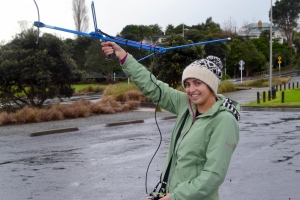Posted by Alice Baranyovits @ABaranyovits

New Zealand’s native pigeon, the kererū, are important seed dispersers as they swallow fruits whole.
Having spent a fair amount of time wandering around Auckland city with a large blue antenna, I have been stopped and asked what I am doing quite a bit. Whilst it was very tempting to tell people I was looking for aliens or just trying to get a good signal for my phone, I did eventually explain to them that I was radio tracking kererū (NZ pigeon; Hemiphaga novaeseelandiae).
On the whole, people seemed pretty interested and would often tell me about the kererū they see around the city.
This got me thinking, perhaps there was a way I could get people to record this information so I could get more of an understanding of where kererū were in the city and where they weren’t. So I created a website, imaginatively entitled ‘The Auckland Kererū Project’ as a platform where members of the public can record their sightings as well as information on the plants in their gardens.
The use of volunteers in research, also known as citizen science, has long been a tool of ornithologists and ecologists – the Audubon Christmas bird count in the US is one of the longest running having started in 1900. More recently the number of citizen science projects has been increasing, helped in part by the internet and the advancement of mobile technology, which has led to much easier data collection.
One of the main benefits of citizen science is that very large data sets can be collected often over a large geographical area and time scale, much larger than what could be collected by a single researcher. Data can also be collected from private land, removing the access issues researchers often face, especially in urban areas. Participants in citizen science can also benefit through increased knowledge and appreciation of the local biota and issues in their local community and through gaining an insight into the scientific process.

Alice is studying how kererū move around fragmented landscapes and more specifically how they utilise the urban environment.
There are some drawbacks, however, that must be taken into account during data analysis. Participants often have variable skill levels which can lead to issues with data quality. Variations in sampling effort both in time and space can also be a concern. Despite these issues, citizen science is a great tool and is likely to become even more prevalent in the future.
Want to get involved? There are many citizen sciences projects in New Zealand – one of the largest is NatureWatch NZ, which listed many different projects you can get involved with. Or how about Landcare Research’s annual garden bird survey? But of course don’t forget about the Auckland Kererū Project!
Alice Baranyovits is a PhD student at the Centre of Biodiversity and Biosecurity, School of Biological Sciences, University of Auckland. She is researching the movements of kererū in urban areas and the implications on seed dispersal of native and introduced plants. She is supervised by Mick Clout, Jacqueline Beggs & George Perry.

It’s Jon here from NatureWatch NZ. Nice article, and thanks for mentioning us. It’s great to encourage more people to record kereru in our cities.
Did you consider setting this up as a project within NatureWatch NZ? It’s always a shame to see the citizen science nature community become fragmented across multiple sites. Note that since November, NatureWatch NZ, as part of the global iNaturalist network, has a sophisticated API that lets external websites use its features from their sites (for making observations as well as displaying observations). See http://naturewatch.org.nz/pages/developers for more information.
That means that you could put NatureWatch NZ under the hood of the the Auckland Kererū Project if you wanted more flexibility than our NatureWatch NZ project page offers. That would also mean that if someone uploaded a photo of a fruiting plant in their garden to the Auckland Kererū Project, it would get identified promptly by the many professional and amateur botanists in NZ on NatureWatch NZ and internationally on iNaturalist. And those users would also tag those observations with phenology information even if the photographer didn’t. It would also mean that we won’t get an Auckland sized hole in the kereru map on NatureWatch NZ.
We’d be happy to help if you’re interested. (We’re also in Auckland in the last weekend of this month running a NatureWatch NZ workshop. See http://naturewatch.org.nz/pages/workshops_nz)
LikeLike
Pingback: Finding the sweet spot for ecological, social and economic values of urban greening | Ecology Ngātahi
Pingback: Celebrating one year of Ecology Ngātahi | Ecology Ngātahi